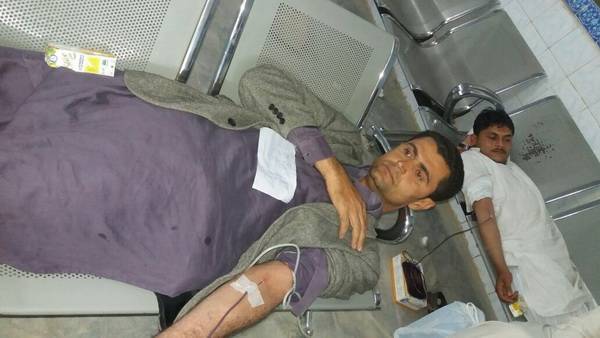
Last Thursday evening Waleed Shaikh, a 25-year-old motor mechanic, felt that the day would end on an ordinary note. After work he would go home, have dinner and later on meet some friends to plan how they would spend Friday, which is a weekly day off for markets in Hyderabad.
But while he was working at his shop in Haider Chowk, a downtown locality near the historic Puqqa Qila fort, he heard the news of a bomb blast at Hazrat Lal Shahbaz Qalandar’s shrine in Sehwan. The initial media reports around 7:15 pm put the casualties in the dozens.
With every minute, the number kept rising. And by 8pm, around 30 minutes, Shaikh was certain that his help might be required beyond prayers.
“I knew that Sehwan is a small town with almost non-existent health facilities and that all the injured would be shifted to either Hyderabad or Karachi. So, I ran to Civil hospital to donate blood,” he says. He was conscious of the utility of his blood group, B negative. “I have donated blood at least half a dozen times.”
That evening, Shaikh and hundreds of other people volunteered to donate blood lined up outside the blood bank of Liaquat University Hospital’s Hyderabad branch, aka Civil hospital. And most of them succeeded. “I thought that the bank has collected as much blood as they required or can store,” said Irfan Mughal, who also donated. “But then finally I got a call, after waiting for almost two and a half hours. They asked me briefly about my health condition, especially illnesses like hepatitis, etc. But, I told them that I was a healthy person.”
According to the Director-general of Health Sindh’s office, 90 people have so far died during and after the blast on Feb 16. Around 350 were injured. Among the injured, 23 were brought from Sehwan to the LUH, including 15 to the Hyderabad branch, which is a tertiary health care provider. Eight others were admitted to LUH Jamshoro, which is located in Liaquat University of Medical and Health Sciences. None of them was critical. An injured patient succumbed on the way and was declared dead at LUH.
“Hundreds of people volunteered that night to give blood," said a senior official at the lab, who requested anonymity. But only 75 pints from as many volunteers could be collected and 50 were used, including over 20 which were sent to Sehwan's taluka hospital known as Syed Abdullah Shah Institute of Medical Sciences.
A few bottles collected that night were also given to victims of the Feb 19 cracker explosion in Hyderabad which left over two dozen injured, among whom 12 persons were hospitalized.
With 31 donors, O positive group was the highest collected that night. There were three B negative donors.
Another official claimed that all donations were taken after hepatitis, HIV and syphilis tests were performed. But they confirmed that the enzyme-linked immunosorbent assay (ELISA) test, which pathologists strongly recommend for blood donation, was not done. “We don't do this test. It's expensive and takes 18 to 24 hours for screening," the official said. According to him, at LUH's lab, free kits are provided by the hospital's administration. When the supply runs short, Rs180 per screening is charged from donors. "ELISA takes the cost to above Rs1,000. The volunteers can't be expected to pay this."
Casualties
A majority of the injured victims, 210, received treatment at the taluka hospital in Sehwan.
As many as 49 were moved to the Peoples Medical University Hospital, Nawabshah, where four people died, and 35 were taken to Chandka Medical University Hospital in Larkana, where eight deaths occurred. Another 17 people were referred to three hospitals in Karachi and as many to Civil Hospital, Dadu. By Feb 19, three days after the blast, 52 victims of the terrorist attack remained hospitalized.
(This article is an online exclusive)
Zeeshan Bhatty is a correspondent with APP

